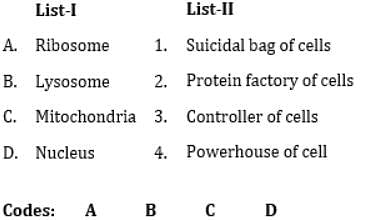Test : Biology - 1 - NDA MCQ
20 Questions MCQ Test NDA (National Defence Academy) Mock Test Series 2024 - Test : Biology - 1
Q1. Match List-I and List-II and select the correct answer by using the code given below
—List-I List-II
A.Vitamin 1.Pepsin
B.Enzyme 2.Carotene
C.Hormone 3.Keratin
D.Protein 4.Progesterone
Code: A B C D
Which of the following elements are present in all protein—?
1. Carbon
2. Hydrogen
3. Oxygen
4. Nitrogen
Code–
Which of the following is involved in controlling blood sugar level?
Which of the following are water-borne diseases?
1. Viral hepatitis
2. Cholera
3. Typhoid fever
4. Amoebiasis
Select the answer using code given below—
Among following which one is the highest source of ascorbic acid?
Which of the following part of blood carries out the function of body defense?
Which one of the following glands in human body enlarged due to goiter?
Deficiency of which one of the following causes knock-knee, bow legs, and pigeon chest in children?
Which one of the following is responsible for blue baby Syndrome?
Consider the following vitamins —
1. Niacin
2. Pyridoxine
3. Riboflavin
4. Thiamine
Which of these are water-soluble vitamins —
Match List-I (Organelle) with List-II (Common names) and select the correct answer using the code given below the Lists —

The largest amount of physical and chemical molecules present in the cells is
Consider the following cell organelles of the organisms
I. Mitochondria
II. Chloroplasts
III. Endoplasmic reticulum
Which of the ones given above is/are semi-autonomous organelle(s)?
Consider the following statements
I. Chloroplast is known as “cell within cell organelle”.
II. Chloroplast is the largest cell organelle found in plant cells.
III. Chloroplasts have single stranded extra-chromosomal DNA.
Which of the statements given above is/are correct ?
|
2 docs|101 tests
|


















